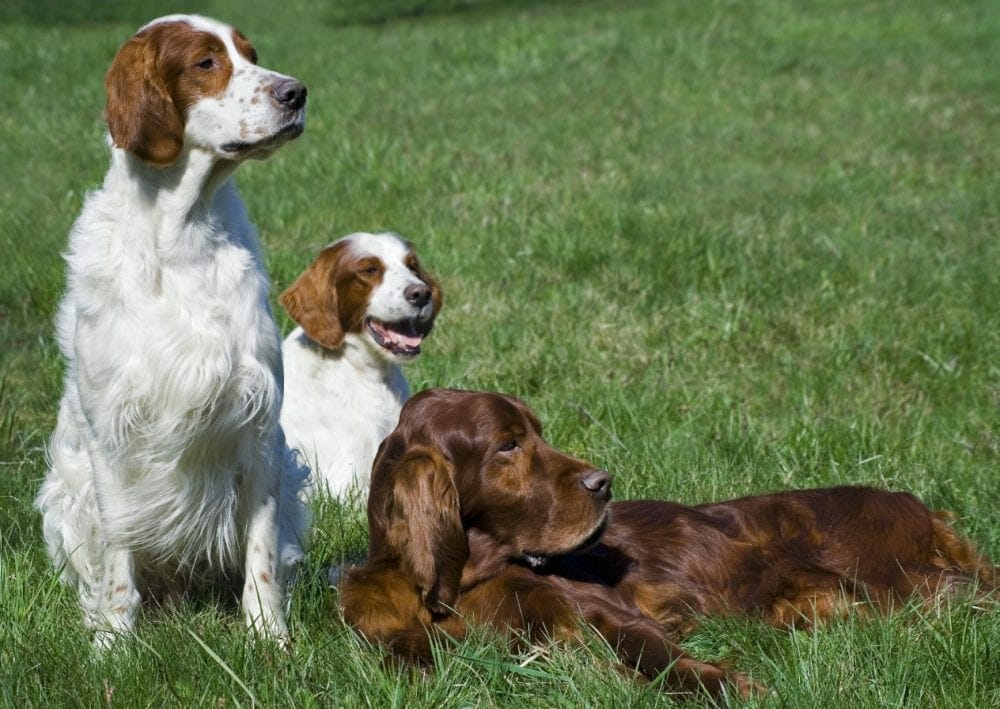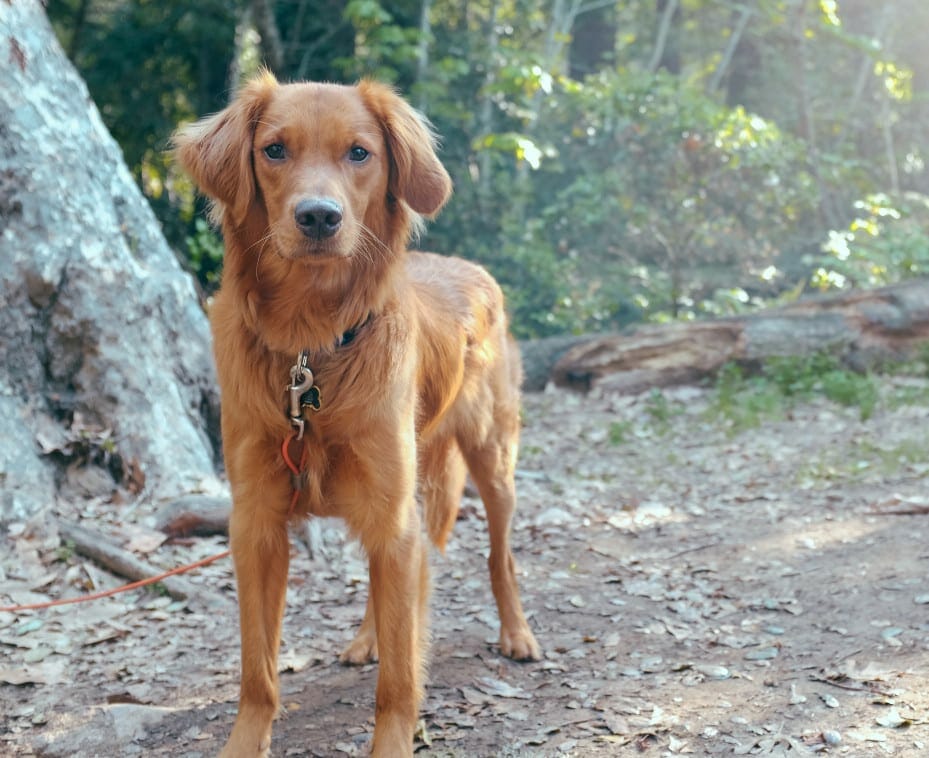Irish Setter

Great Dog Breed for Kids
The Irish Setter, though a large dog, has been found to be an ideal companion for children. Their sophisticated, noble appearance hardly reflects their comical, playful nature.
Although Irish Setters can be a bit rowdy for very young children, older kids are quick to befriend this gentle giant, which is known to be a kid at heart throughout its life. This breed’s sweet, serene temperament coupled with its spirited nature makes it both a friend and lifelong family member.
 Irish Setter Breed Characteristics
Irish Setter Breed Characteristics
Origin
Hailing from the British Isles, the gorgeous Irish Setter made its debut as a gundog beginning in the 1800s for those hunting birds on foot. The dogs were bred to be agile and swift in its movements as a hunter.
The Irish Setter’s deep maroon coat made it easy to spot as it chased after fowls in the rolling green fields of Ireland. In more recent times, their richly colored coat continues to draw attention, making them highly coveted as pets and show dogs.
The Irish Red and White Setter is a different dog breed from its Irish Setter cousin. The Irish Red and White Setter is shorter and stockier and has a coat that combines white and red fur.

Appearance
Without a doubt, the Irish Setter’s luxuriously silky mahogany coat is their most prized asset. Their wavy coat ranges in length, but their chest, legs, and belly have the longest fur. This dog possesses long, drooping ears and a fairly large muzzle. Their long, lean body features an elongated neck and legs.
The Irish Setter certainly emanates a majestic façade in its stature and gait.
Height and Weight
Male Irish Setters weigh up to 70 pounds, while the females can potentially weigh about 60 pounds.
In regard to the average height (ending at the withers) of both sexes, males can grow to be 27 inches tall, and females must be at least 25 inches tall in order to meet the breed standard.
Lifespan
The Irish Setter is generally healthy. If adequate care is given throughout the dog’s life both at home and through veterinary care, this breed can live to be between 12 and 15 years old.
Irish Setter Golden Retriever Mix
The Irish Setter Golden Retriever Mix is quite popular, combining some of the best aspects of both breeds. This mix is also known as a Golden Irish, a Golden Irish Setter, Irish Golden, and Irish Retriever. The Golden Retriever Irish Setter mix is a large dog that lives 10 to 15 years. A Black Irish Setter is a result of breeding an Irish Setter with a Black Labrador Retriever. Other popular mixes include the Irish Setter Poodle Mix and Irish Setter Doodle.

Irish Setter Personality
Many describe the Irish Setter’s personality as larger-than-life. Both dogs and puppies are outgoing and flashy while also remaining sweetly affectionate at the same time.
Irish Setters can also be clown-like and mischievous while also displaying traits of independence and intelligence. The breed is a good mix of everything, to say the least.
As mentioned before, the lighthearted nature of Irish Setter dogs and puppies makes them child, dog, and cat friendly. Toddlers and other small children should be carefully monitored in the presence of a large dog like the Irish Setter.
This breed is also admired for its adaptability. If brought along on a hunting trip or engaged in training, they can be quite serious and determined in their demeanor. However, when playtime rolls around, this breed is up for games of any kind. This dog can be the ultimate fun-loving playmate.

Proper Care of the Irish Setter
Grooming Needs
For the coat of the Irish Setter to remain in tip-top shape, frequent grooming is non-negotiable. A soft-bristled brush or a comb should be used twice weekly to gently brush out the dead hair and remove any knotting.
It is also suggested that dogs and puppies be bathed once per month to ensure its glorious coat remains shiny and healthy.
Besides this, keeping its nails trimmed and its ears clean is advised. Cleaning the ears can help prevent ear mites.
Food
Because of their large size and high energy levels, Irish Setter dogs and puppies have a tendency to scarf down any food put in front of them. It is discouraged to give this dog lots of treats and food that is added to its normal meals.
Irish Setter dogs and puppies are prone to bloat, which can be deadly. Vets recommend that their food be given in small portions at a time to prevent eating too quickly and becoming bloated.
This breed should be given premium quality food that is high in protein.
Exercise
Irish Setters are a member of the Sporting Group, which is known to have an abundance of energy it needs to let loose each day. At least 40 minutes of consistent physical activity is recommended for this breed. Open spaces are ideal for this dog to work off its energy.

Early Training
Because this breed can be on the obstinate side, early training is advised during puppyhood. Socialization and obedience training can be beneficial to puppies.
Even as adults, Irish Setters thrive by learning new tricks and commands, performing especially well when treats are used as an incentive. Training is most effective when approached with an element of fun since this breed is quite playful at heart.
Irish Setter Health Issues
In spite of its hardiness, there are several notable health conditions that prospective owners should be well aware of before purchasing from a breeder. A reputable breeder should be able to certify through early screenings that the dog is free of inherited disease. Any predispositions the dog may have to a condition should be fully disclosed to the buyer.
Below are the commonly observed health issues that Irish Setters tend to face:
- Retinal atrophy. This inherited condition happens when cellular death is programmed to occur in the rods within the eye of the dog or puppy. This can lead to permanent blindness in the eyes if not addressed.
- Hip dysplasia. A majority of large dog breeds often contend with hip dysplasia as they grow older. Dysplasia comes about due to the bone joints being out of place and rubbing together painfully. This can often lead to lameness, chronic pain, and a significant decrease in activity.
- Hypertrophic osteodystrophy. Primarily a problem in big dogs, hypertrophic osteodystrophy happens when a dog’s rapid growth causes its joints to swell and become agonizingly painful. Limping is a common symptom.
- Hypothyroidism. This occurs when the thyroid is functioning under its normal threshold. Gaining weight, losing hair, and lethargic behavior are all by-products of this disease.
- Epilepsy. Setters are prone to epilepsy, which is a neurological problem that involves frequent seizures.
- Osteosarcoma (bone cancer). Most common in larger dogs, osteosarcomas, or bone cancer, is a devastating disease. This form of cancer tends to quickly spread to other parts of the body, thereby making it nearly impossible to cure.
For any worries or concerns about health, a qualified veterinarian is always the most valuable and accurate source of help.
Compare this breed with a Labrador Retriever. Both are larger dogs, but the Labrador has different colors and coats, but similar temperament as well as sharing the common Labrador hip dysplasia condition.




 Irish Setter Breed Characteristics
Irish Setter Breed Characteristics